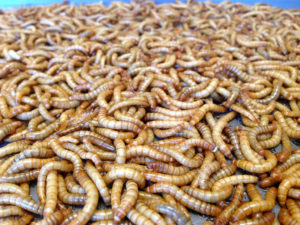Breeding and farming mealworms is one of the most practical processes to undertake, even for people without much building experience.
One of the most common methods of farming them is to have multiple plastic tubs stacked on a rack, with each tub having mealworms at different stages of their life cycle – ensuring a constant supply, but, there are many possible options.
 Life cycle:
Life cycle:
Eggs for 1-2 weeks
Mealworms for 10 weeks
Pupa for 1-2 weeks
Beetles for 2-3 months
Raising mealworms is fairly easy since they are prolific breeders and are hardy insects. It is also fairly inexpensive and can save you quite a bit of money if you use a lot of worms every month. They rarely smell, are easy to care for, and don’t take much work.
Breeding will take a while to get started, but once there are plenty of beetles laying eggs you will have worms for as long as you need. You should start with at least one hundred mealworms, but can begin with many more. Then, all you need is a container, substrate, and a source of food and water. – Mealwormcare.org
- Very low maintenance
- Great food for chickens and fish
- Compact, cheap & easy to build
- Low Maintenance
- Recycles your waste much faster than composting
- Can generate solid & liquid fertiliser
- Scalable to many sizes.
- Totally Organic process
Learn More >>
Large but simple overview of meal worms and their life cycle, with pictures @ Westknollfarm.com
Science on how amazingly efficient meal worms are @ ncbi.nlm.nih.gov
Basic drawer style mealworm farm overview @ Wildcare.org.au
Do it yourself >>
DIY Meal-Worm farming @ Youtube
Meal worm farm DIY @ VelaCreations.com
